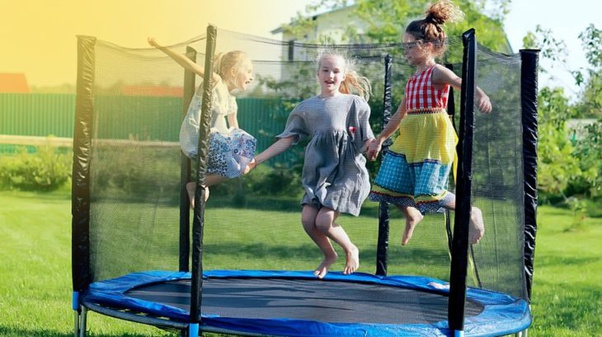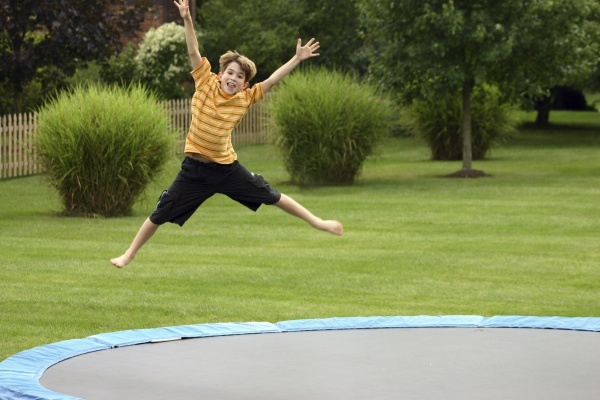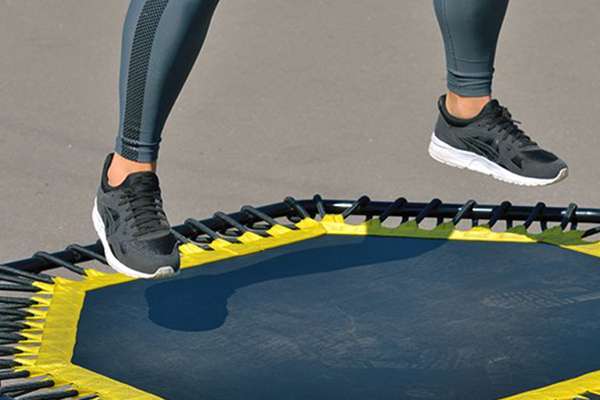Due to its cardiovascular advantages and a good influence on balance and stability, trampolines are fast becoming popular in personal exercise routines. You might be wondering how many bounces it would take to replace your morning run if you decide to bounce your way to better health.
On a trampoline, it takes around 500 jumps to cover a mile. When compared to the 2,000 steps required to complete a mile when jogging, it’s clear that jumping on a trampoline would be a more efficient workout.
There are several advantages to jumping on a trampoline rather than jogging. The change in impact on your body alone is reason enough to give it a go. For most individuals, having pleasure while working out while taking less time out of their day is a significant advantage. If you can’t get away owing to children or a hectic schedule, you can squeeze in a few minutes to get in a solid exercise.
How Does a Trampoline Mile Compare to a Running Mile?
Simply jumping on a trampoline 500 times is the same as jogging a mile. When compared to the 2,000 steps it takes the typical individual to walk a mile; this is a significant difference. The numbers don’t lie: bouncing on a trampoline is less taxing on the body.
Those who have trouble with the impact of jogging could benefit from a trampoline workout. It’s not only simpler on you, but it may also feel like a lot more fun and bring out the kid in you.
Consider the 2,000 steps required to run or walk a mile once again. When you fall to the earth, a force is applied to your body. The same impact may be achieved in just ten minutes on the trampoline while protecting your joints and muscles.
How Many Calories Do You Burn On A Mini Trampoline?
Men burned an average of 12.4 calories per minute with the JumpSport workout routine, while women burned an average of 9.4 calories per minute without counting warm-up and cool-down time. Those calorie-burning levels are about equal to jogging on flat ground at 6 miles per hour.
A trampoline is a great way to get a full-body workout. Rebounding calorie burn can help you achieve your weight-loss goals. According to Ramp Up Trampolines, if you weigh 170 pounds, jumping on a mini-trampoline may burn 8 calories every minute, resulting in 440 calories burnt each hour.
Is it possible to eliminate stomach fat by jumping on a trampoline? The good news is that trampoline jumping does burn calories. While belly fat is tough to shed, it may be burned off by practicing basic aerobic activities on a trampoline. To decrease belly fat, you’ll need to do around 150 minutes of moderate aerobic activity each week.
Keeping This in Consideration, is a Mini Trampoline a Good Workout?
According to new research published by the American Council on Exercise (ACE), bouncing on a tiny trampoline for less than 20 minutes is just as beneficial for your health as running, but it feels better and is a lot more fun.
Does Trampolining Burn Calories?
It exhausts you and tones you up without making you wince or grimace in fear of losing your cartilage. According to studies, ten minutes of trampolining burns the same amount of calories as half an hour of running. This is why trampoline parks have grown in popularity.
Do You Burn More Calories Walking or Jumping on a Trampoline?
Both rebounding and walking are low-impact exercises. Each one offers a slew of health advantages. There is a slight difference between rebounding and walking when it comes to establishing a fair comparison. For people of all ages, these two exercises are easy. They’re also free-hand workouts. As a result, you won’t require any exercise equipment to begin your workout.
You may use the rebounder at home, even in your bedroom, to get some exercise. A rebounder is a little trampoline that can be used inside your room. Both in the rain and in the sun, you may workout on the rebounder. They’ve put together a list of rebounders based on your requirements.
Despite the fact that I currently perform rebounding on a regular basis, hearing its name shocked me. And I believe I am not alone in this. Some people are still unaware of the many health benefits of rebounding. As a result, I’d like to give you a quick overview of rebounding and walking as a kind of exercise.
Rebounding has recently become a popular type of exercise. To workout with it, you’ll need a tiny trampoline, often known as a rebounder. Jumping, bouncing, and jogging are all exercises you may do on the rebounder. It’s a unique activity, and you won’t need to utilize any additional weight.
It may target all of your body’s cells, unlike other activities. The key feature of rebounding is that it changes the G-force. You may experience a sense of weightlessness when you reach the apex of each jump. Start with a low-intensity workout that you can do for 5 minutes each. It might also be high-intensity interval training, depending on your needs.
Walking burns less calories than rebounding. According to studies, a 30-minute rebounder workout may burn anywhere from 150 to 210 calories. Your weight, age, and workout intensity all have a role.
Walking burns calories as well, but not as much as rebounding. If you walk for 30 minutes (brisk walking), you will burn around 110 to 150 calories. The number of calories burned varies based on your weight, age, and the intensity of your workout.
Can You Lose Weight by Jumping on a Trampoline?
You can and will reduce weight, without a doubt. It may be a low-impact workout, but it will get your heart pounding and engage muscles you didn’t realize you had or weren’t aware of. It has a high calorie-burning efficiency. If you combine a nutritious diet with frequent trampoline workouts, you’ll be shedding pounds in no time.
How Does a Trampoline Help With Balance?
Every bounce will work out some of the same muscles that would catch you if you were to misstep and fall. When you bounce, your body tries to keep you on your feet naturally.
So, while you’re having fun hopping away, your body is actually on high alert, catching you and exercising your muscles with each bounce. You’re also strengthening your core, which aids with balance and stability.
When you go off the trampoline and onto flat land, those muscles will have already been developed up, assisting you with balance and stability.
What Are Some Other Advantages of Using a Trampoline for Exercise?
Trampolines are a fantastic way to get in some exercise. They’re not simply entertaining. It is incredibly gentle on your body because it is a low-impact workout.
Workout that is both efficient and effective. Increase your weight reduction and general wellness without the fear of a long run and with lots of stamina!
- It can be done anywhere! Work out in your living room, yard, or anywhere else with a sturdy surface.
- It makes no difference what the weather is like! Rain or sunny, jump on a trampoline.
- It’s preferable to running. Trampolining is also 68 percent more effective than a 30-minute jog, according to NASA.
- Stabilize the situation. Jumping can help with coordination and balance.
- It also works your abs. Jumping strengthens the core.
Bones need to be strengthened. Someone with osteoporosis can benefit from trampoline workouts. Jumping’s G-force exerts so little strain on your bones that it can actually help them develop. According to NASA research, it also strengthens bones and increases density.
What Should I Look For When Buying a Trampoline?
Keep in mind what you require when looking for the ideal trampoline. Are you seeking for something that you can carry with you everywhere you go? If that’s the case, make sure it’s lightweight and easy to fold.
Weight Capacity
It’s possible that your weight has an impact on the weight capacity. The majority are in the 250-350 pound range.
Construction
Look for a steel frame, as they are the most durable.
Budget
Remember to select one that is both cost-effective and meets your requirements.
Should I Wear Shoes While Rebounding?
No, you don’t have to wear shoes; in fact, going barefoot may be more helpful. Shoes might cause your trampoline to rip or tear.When you put on shoes, the bottoms of your feet are flattened again, and you won’t get the full impact.
You can feel the mat and improve your balance by going barefoot.
Is Stretching Necessary Before a Trampoline Workout?
To avoid injury, you should always stretch or warm-up before any activity. Try some small bounces for approximately 5 minutes before jumping on your trampoline to allow your body to warm up.
How Can Someone Be Safe When Jumping On A Trampoline?
Precautions should always be taken when using this or any other training equipment.
- The first and most crucial step is to place it on level ground. To avoid sliding, almost all mini trampolines come with rubber foot guards.
- Another important point to remember is making sure you have enough headroom and movement space around you.
- It’s a good idea to double-check it before each workout to avoid an accident.
As you bounce away for 5, 10, 20 minutes, it may seem insignificant. Because it’s such a low-impact workout, you might not feel the full force of it until you sit down. Begin with shorter periods of time and gradually increase your endurance.


